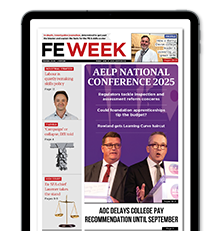Last weeks’ article by Catherine Gray in these pages shows the importance of research is recognised ever more widely in the sector. Twenty-seven years ago, when the Learning & Skills Research Network (LSRN) was founded, only a small band of enthusiasts and a few larger colleges were engaging with it and little infrastructure existed to support it. Things have improved, but there’s a way to go.
Among the positive developments, we can cite that over twenty LSRN convenors across England and Wales organise activities for hundreds of active practitioner-researchers. In addition, colleges committed to research have combined to form the Research College Group, the Association of Colleges has set up the Research Further initiative and the Society for Education & Training encourages research engagement through its Intuition magazine. Research activity in the sector is thriving.
Sadly, interest elsewhere about research in the sector seems to be dwindling. The current ESRC Education Research Programme hardly mentions FE at all and the Education Endowment Foundation, now a major research funder, restricts its work largely to schools.
In the university sector, academics who focus on FE, adult education and skills seem in short supply. This relative neglect should act as a clarion call for the sector to stand up, define its own expectations of research and start making demands upon the wider system.
The rise of research interest amongst practitioners is good news: it’s essential if a culture of research-use is to develop across the sector. Skilled researchers and infrastructure that supports them are important.
To convince leaders and funders to invest in research, however, requires more than a cohort of individuals pursuing their separate interests. It requires a connected system to produce sound evidence on pertinent questions, make it useful and then ensure it is put to use.
Perennial issues of practice and leadership in FE need a strong base of evidence: teaching methods in vocational areas, course design, employer engagement, college structure, patterns of governance and countless others.
Our relative neglect should act as a clarion call
To develop this requires collective effort, both within and beyond the research community: teachers, support staff, leaders and other intermediaries all have a part to play in identifying priorities, designing and commissioning studies and interpreting and using their findings.
It’s time for the sector to pull together to define its specific knowledge requirements, rather than just accepting generalisations from school research or the absence of good evidence.
These systems exist in other sectors. Health and social care have the National Institute for Health and Care Research). Manufacturing has the Advanced Manufacturing Research Centre.
In one inspiring governmental initiative, called for by Sir Paul Nurse and Sir Patrick Vallance, the Transforming Evidence network, is working with policymakers to identify Areas of Research Interest across government departments to help decision-makers in public services put clear knowledge requirements to research councils and other funders.
Not only could the FE and skills sector take the initiative by spelling out areas in which it needs better knowledge, it could also build up its own approach to research production. Iterative, multi-disciplinary studies could focus on the practical knowledge the sector needs to drive improvement. This could entail teachers and leaders working closely with researchers to specify project designs and modify, adapt and apply the results in real time.
FE has a proud tradition of imaginative development work: bringing on new courses, new learner groups and new assessment methods. It already has expertise in many fields that carry out research in this way: agriculture, healthcare, automotive engineering and the performing arts, for example. With a research stake in so many sectors, why not extend the ‘R&D’ approach to education research too? Good examples already exist in colleges, albeit on a small scale.
The pay-off for such engagement would be better and more convincing proposals for research funding. Greater investment in research is more likely when high quality, use-directed research proposals are put forward – a potentially important additional revenue stream to drive classroom improvements and learner outcomes.
With an ever-growing cadre of trained and skilled practitioner-researchers available, it’s surely time to develop the infrastructure and systems needed to capitalise on their individual capacities for the wider benefit of the sector.















The Education Research Programme’s funder restricted the research to schools only.